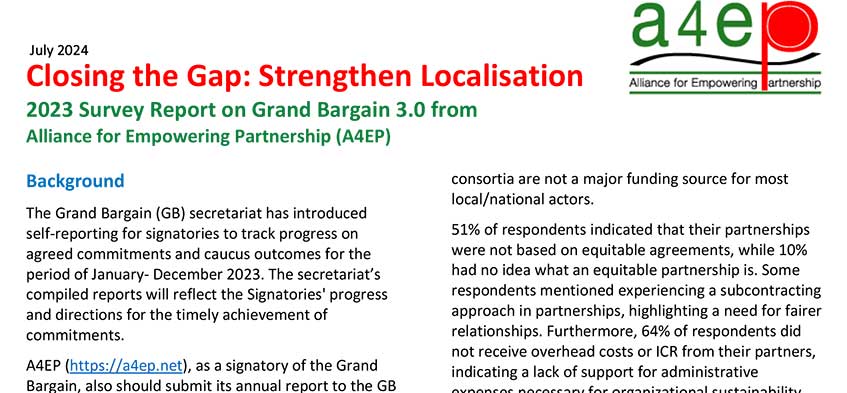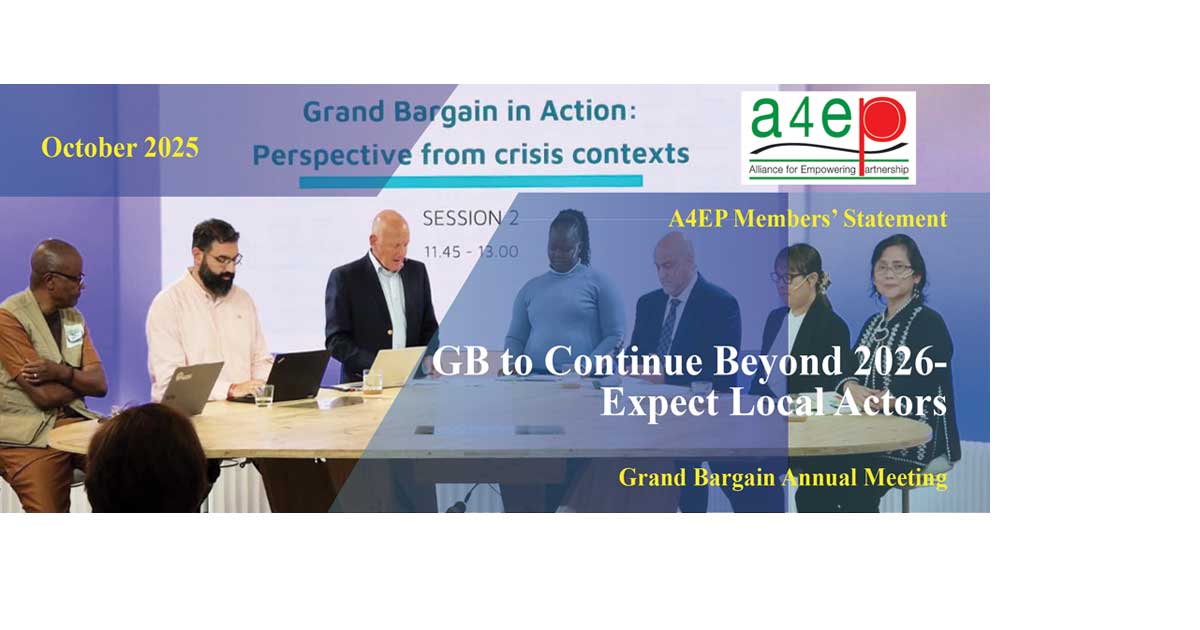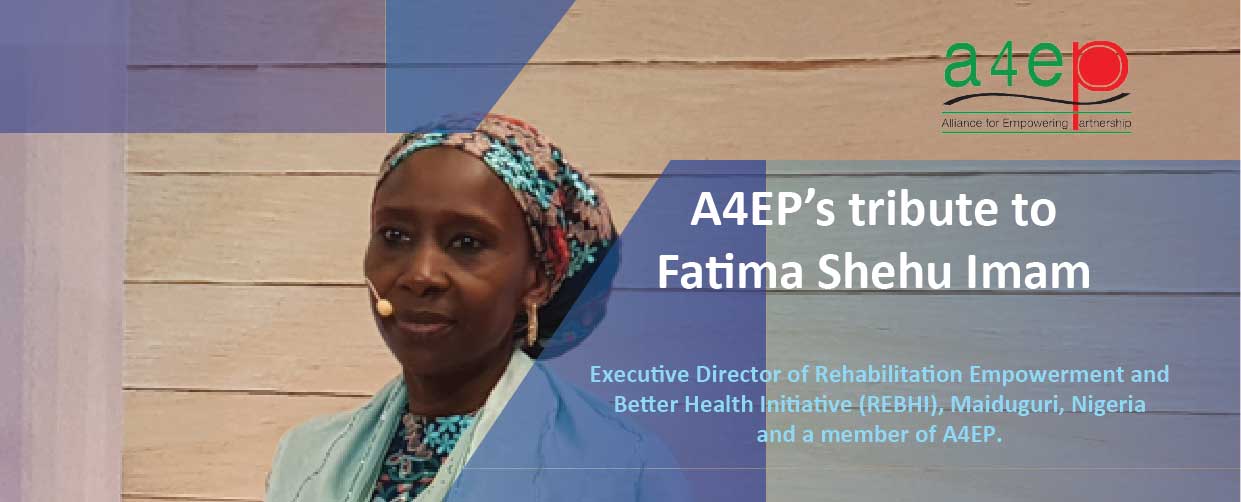July 2024
Closing the Gap: Strengthen Localisation
2023 Survey Report on Grand Bargain 3.0 from
Alliance for Empowering Partnership (A4EP)
Background
The Grand Bargain (GB) secretariat has introduced self-reporting for signatories to track progress on agreed commitments and caucus outcomes for the period of January- December 2023. The secretariat’s compiled reports will reflect the Signatories’ progress and directions for the timely achievement of commitments.
A4EP (https://a4ep.net), as a signatory of the Grand Bargain, also should submit its annual report to the GB secretariat. However, A4EP is a network of global south organisations and does not provide funding directly. Rather, its members receive funds from different donors and intermediaries. Therefore, A4EP conducted a survey from 23 June 2024 to 10 July 2024, asking its members and other local/national actors questions in five categories aligning with the Grand Bargain reporting template. It received 77 responses from across the globe, capturing real-time perspectives about funding and other issues that promote localisation and locally-led response.
Objective
The primary objective of the survey was to capture real-time progress on funding and other issues related to the commitments made by Grand Bargain Signatories and the outcomes of various caucuses. This includes promoting localisation, local leadership, and locally-led humanitarian responses. Additionally, the survey aimed to identify discrepancies or gaps between donor reporting and the actual ground realities.
Survey summary
The survey found that 36% of respondents received no funding in 2023. Among those who did receive funds, 43% did not receive multiyear humanitarian funding, indicating a significant gap in funding stability and predictability. Only 28% of respondents received flexible funds, with 72% receiving none, suggesting that many organisations faced restrictions on fund usage, limiting their ability to respond effectively to changing circumstances.
45% of humanitarian funding came from INGOs, highlighting them as the largest funding source with diverse support from other donors. Signatories and donors must establish stronger supportive and monitoring mechanisms for INGOs to foster mutual accountability, equal partnership, and quality funding. 49% of respondents reported receiving no humanitarian funds through consortia, indicating that consortia are not a major funding source for most local/national actors.
51% of respondents indicated that their partnerships were not based on equitable agreements, while 10% had no idea what an equitable partnership is. Some respondents mentioned experiencing a subcontracting approach in partnerships, highlighting a need for fairer relationships. Furthermore, 64% of respondents did not receive overhead costs or ICR from their partners, indicating a lack of support for administrative expenses necessary for organizational sustainability.
43% of respondents participated in humanitarian coordination bodies, while 45% did not. This mixed participation suggests that while some local/national organisations are involved in coordination efforts, many are still excluded, and 12% are unaware of these opportunities. Some respondents expressed concerns about the limited presence of local/national organizations in Humanitarian Coordination Bodies, noting that their voices are often overlooked. Others mentioned that local NGOs’ participation in these bodies seems ceremonial, focused on photo opportunities rather than substantive engagement.
49% of respondents reported that their donors or partners had well-established accountability frameworks or systems in place to collect and act on feedback from affected communities, encompassing gender, age, and diversity considerations. However, 31% said no such systems existed, and 19% were unaware of them, indicating a need for more widespread implementation and awareness of feedback mechanisms. Among the women-led organisations, representing 18% of the total respondents, only 29% received direct humanitarian funding, showing a significant gap in support for women-led initiatives. Some respondents noted that funding for women’s empowerment and inclusion is often short-term and lacks a complete cycle, failing to meet project objectives in many cases.
58% of respondents reported no experience with risk-sharing in their partnerships. Respondents also emphasized the need for simplified project proposal submission processes and reporting templates with fewer technical complexities to facilitate easier access for non-technical small NGOs and CBOs. These findings provide a comprehensive overview of the funding and operational challenges faced by local/national actors in the humanitarian sector, highlighting areas for improvement in achieving the Grand Bargain commitments concerning the localisation of humanitarian aid.
Methodology
A4EP designed an online survey questionnaire aligned with the Grand Bargain Reporting Template for Signatories to reflect real-time progress on funding and other issues, or to highlight gaps in signatory reporting. The online Kobo survey link was circulated among the Global South network members of local/national humanitarian actors. The survey remained open for 19 days, allowing local actors to respond. After the survey period ended, A4EP closed the survey link, calculated, and analysed the data, and prepared the report.
Geographic location of respondent local/national actors to the survey
 The survey received responses from local/ national actors across 14 countries, with the highest response rate from Pakistan (29%) and South Sudan (21%). Other notable contributions came from India (12%) and Bangladesh (8%). The rest came from the Philippines (7%), Uganda (7%), Yemen (4%), Nigeria (4%), Indonesia (3%), and 1% each from Zambia, Nepal, Myanmar, Colombia, and Afghanistan. This diverse geographic spread provides a broad perspective on the following key elements of localisation and locally-led response.
The survey received responses from local/ national actors across 14 countries, with the highest response rate from Pakistan (29%) and South Sudan (21%). Other notable contributions came from India (12%) and Bangladesh (8%). The rest came from the Philippines (7%), Uganda (7%), Yemen (4%), Nigeria (4%), Indonesia (3%), and 1% each from Zambia, Nepal, Myanmar, Colombia, and Afghanistan. This diverse geographic spread provides a broad perspective on the following key elements of localisation and locally-led response.
Limitation
The survey encountered some limitations both in the reporting from local/ national actors and the calculation of their responses. Since the survey questionnaire was based on the Grand Bargain Reporting Template for Signatories, it was not equally applicable to local/national actors. As a result, some respondents found it challenging to provide detailed funding information, such as the amount and percentage of direct funding they received in 2023 from various sources (donors, government, philanthropic organisations, etc.), the rate of indirect funding, and the amount and percentage of unearmarked, softly earmarked, earmarked, and tightly earmarked funding. These classified reporting terms are more applicable to signatories and donors who have been oriented by the Grand Bargain Secretariat for effective and accurate reporting. Local/national humanitarian actors who responded to our survey did not have the benefit of this orientation, making it difficult for them to respond accordingly.
Major survey findings
1. Quality funding
1.1 How much % of Total Humanitarian Funding in 2023 was Multi-year?
 43% of respondents reported receiving no multiyear humanitarian funding in 2023. The remaining responses varied, with 23% receiving 1-10% of their funding as multiyear. Only 8% received more than 51% of their funding as multiyear, indicating a significant gap in the stability and predictability of funding for many local/national organizations.
43% of respondents reported receiving no multiyear humanitarian funding in 2023. The remaining responses varied, with 23% receiving 1-10% of their funding as multiyear. Only 8% received more than 51% of their funding as multiyear, indicating a significant gap in the stability and predictability of funding for many local/national organizations.
1.2 How much % of the total humanitarian funding in 2023 was flexible?
Flexibility was defined as unearmarked, softly earmarked, earmarked, and tightly earmarked, e.g., Budget flexibility of at least 10%; Pre-financing or simplified release of funds; Simplified procedures for no-cost extensions and carryover, etc.
Only 28% of respondents received flexible funding in some form, with 72% receiving no flexible funding. This suggests that many organizations face restrictions on how they can use the funds, potentially limiting their ability to respond effectively to changing circumstances.
2. Localization
2.1 Sources of Humanitarian Funding in 2023
49 out of 77 organisations, accounting for 64% of the total respondents, reported receiving humanitarian funding from various sources such as government donors, philanthropic donors, INGOs, UN agencies, RCRC, national intermediaries, or other institutions. Some also received funds from multiple sources. Conversely, 36% of respondents stated they did not receive any funding.
Of the 64% of respondents who reported receiving funds, they cited various sources of their funding- that was a multiple-choice question, allowing organizations to indicate funding from multiple donors and partners.
Among those who received funding, 14% came from government donors, 26% from philanthropic donors, and 45% from INGOs. UN agencies provided funding to 10%, RCRC to 4%, national NGO intermediaries to 21%, and 26% from other actors. This highlights INGOs as the largest funding source, with diverse support from various other donors.

2.2 Humanitarian % funding received through a consortium where the respondent is a member or co-applicant
49% of respondents reported receiving no humanitarian funding through consortia. For those who did, the majority (21%) received 1-10% of their funding this way. This indicates that consortia are not a major source of funding for most respondents, although they play a role for some.
2.3 Experience on Equitable Partnership Agreements in 2023 humanitarian funding
51% of respondents indicated that their partnerships were not based on equitable agreements, while 39% said they were. In the comments, some respondents mentioned experiencing a subcontracting approach in partnerships. This highlights a significant area for improvement in fostering fair and balanced relationships between local/national actors and their partners.
2.4 Local/National Organizations receiving ICR/overhead cost in 2023 humanitarian funding
64% of respondents did not receive any overhead costs from their partners. Only 13% reported that all their partners provided these costs, indicating a lack of support for the administrative expenses necessary for organizational sustainability.
3. Participation
3.1 Participation of local/national organizations in humanitarian coordination bodies (HCTs, ICCGs, and CBPF Advisory Boards) in 2023
43% of respondents participated in humanitarian coordination bodies, while 45% did not. This mixed participation suggests that while some local/national organizations are involved in coordination efforts, many are still excluded or unaware of these opportunities.
Some respondents expressed concerns about the limited presence of local/national organizations in Humanitarian Coordination Bodies, noting that their voices are often overlooked despite having hybrid meeting systems. Others mentioned that local NGOs’ participation in these bodies seems ceremonial, focused on photo opportunities and validation rather than substantive engagement. There were also calls for the establishment of a dedicated humanitarian aid digital platform to enhance awareness and accessibility for small community-based frontline organizations. Respondents emphasized the need for simplified project proposal submission processes and reporting templates with fewer technical complexities to facilitate easier access for non-technical small NGOs and CBOs.
3.2 About donors/INGOs/UN system systematically collecting and acting upon feedback from communities and people affected by crisis on their level of satisfaction, paying particular attention to the gender, age, and diversity of those giving feedback
49% of respondents reported that their donors or partners had systems in place to collect and act on feedback from affected communities. However, 31% said no such systems existed, and 19% were unaware of them. This indicates a need for more widespread implementation and awareness of feedback mechanisms.
Nearly all respondents who reported having these systems in place indicated that their organizations have well-established accountability frameworks that encompass gender, age, and diversity considerations. These organizations have adopted various policies, including a Code of Conduct, Do No Harm Approach, Protection from Sexual Exploitation, Abuse & Harassment (PSEAH), Anti-Corruption measures, and Complaints policies, among others, to systematically collect and act upon feedback from communities and people affected by crises.
4. Gender
4.1 Direct humanitarian funding for women-led local/national organisations from donors/UN agencies/INGOs in 2023
Among the women-led organizations, representing 18% of the total respondents, only 29% received direct humanitarian funding, showing a significant gap in support for women-led initiatives.

4.2. Local/national organization received humanitarian funding in 2023 that ensures the empowerment of women and inclusion
37% of respondents received funding aimed at empowering women and promoting inclusion, but a majority (56%) did not. This suggests that more targeted efforts are needed to ensure gender-sensitive funding practices.
In the comment section, a few respondents noted that funding for women’s empowerment and inclusion is often short-term and lacks a complete cycle of support. For instance, initiatives like small business start-ups for women, entrepreneurship training, skill development, follow-up support, risk-sharing mechanisms, and insurance are frequently not included. This incomplete support cycle sometimes leads to failures in women’s entrepreneurship initiatives.
5. Risk Sharing
5.1 Local/National organizations experience risk-sharing in partnerships (e.g., by adopting internal policies or guidance or by piloting the Risk Sharing Framework in operationalizing partnerships in specific contexts)
58% of respondents reported no experience with risk-sharing in their partnerships. Only 33% experienced well-designed and jointly discussed risk-sharing mechanisms. This points to an area where better collaboration and mutual understanding can enhance partnership effectiveness.
www.a4ep.net
For queries about this writeup:
[email protected]; [email protected]
The Alliance for Empowering Partnership (A4ep) is a network of independent and locally grown civil society organisations in the global south and global activist practitioners advocating to transform aid architecture based on community realities. It is a signatory to the Grand Bargain, one of the few that represents local and national humanitarian actors.













